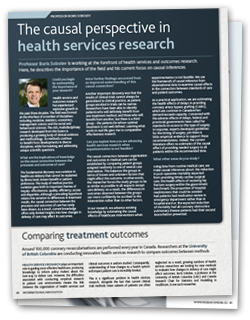Health Care
from Sobolev et al. Health Care Evaluation Using Simulation. Springer 2012
Causal perspective in Health Services Research
 Causal reasoning in science relies on the premise that for each observed phenomenon, there exists an underlying mechanism that links cause and effect. In health services research, the description of such a mechanism involves specification of the structures, processes, and outcomes of medical care, as exemplied by the works of Avedis Donabedian (1919–2000). Donabedian held that the structures of care are the facilities, equipment, services, and human resources needed to provide care, as well as the qualications of the care providers. The processes of care are the clinical and managerial activities, steps, and procedures involved in the provision of treatment within the defined structures of care. Finally, the outcomes of care are the results of the activities through which medical care is provided. Therefore, within the Donabedian triad, causal mechanisms should explain at least two sets of dependencies: those between structures and processes and those between processes and outcomes.
Causal reasoning in science relies on the premise that for each observed phenomenon, there exists an underlying mechanism that links cause and effect. In health services research, the description of such a mechanism involves specification of the structures, processes, and outcomes of medical care, as exemplied by the works of Avedis Donabedian (1919–2000). Donabedian held that the structures of care are the facilities, equipment, services, and human resources needed to provide care, as well as the qualications of the care providers. The processes of care are the clinical and managerial activities, steps, and procedures involved in the provision of treatment within the defined structures of care. Finally, the outcomes of care are the results of the activities through which medical care is provided. Therefore, within the Donabedian triad, causal mechanisms should explain at least two sets of dependencies: those between structures and processes and those between processes and outcomes.
Operations research conducted in the second half of the 20th century was instrumental in revealing the links between structures and processes in various social and industrial systems. The paradigm and analytic approaches of the field gradually came to be included in the Methods sections of articles in the health services research literature concerned with improving the quality of care. At the same time came the realization that processes of health care differ from those of manufacturing; variability in patients and reliance on expert judgment were cited among the most significant differences. The link between a clinical process and treatment outcomes has proven the most challenging for operations analysis because of uncertainties inherent in diagnosis and choice of treatment, as well as the stochastic nature of the response to treatment exhibited by many medical conditions.
During the same period, health services research created a solid foundation for empirical analysis of the outcomes of care delivered to patient populations. First, clinical evaluative studies have documented wide variations in treatments and outcomes in most health care systems. For example, it has been reported that 20% of surgical procedures performed have no clear benefit for patients; conversely, a substantial number of patients do not receive treatments that could improve their condition. Second, it has been established that even in cases where there is an indication for a specic treatment and patients receive the treatment and experience the anticipated benefit, the particular response may differ from one patient to another. In specialties such as surgery and oncology, this individual-level variation may also be related to the potential harm of treatment, such as complications or death. The next natural milestone was establishing factors that influence the outcomes of care. For example, researchers investigating the link between postoperative processes and outcomes have shown that lack of improvement in a patient’s condition might result from factors related to either the condition or the clinical process, or both.
The structure-process-outcome model provides a convenient idealization in evaluations of complex interventions in health care. Usually, such interventions constitute changes in one or more signicant aspects of care delivery. Within the model, interventions could be thought of as replacements of one conguration of the structure and process of care with another. Replacing a conguration could be further viewed as modifying some parameters of the structure, such as procedural volume, or the process, such as time from hospital arrival to angioplasty.
To illustrate this idea, suppose variable ![]() characterizes the process of care, so that
characterizes the process of care, so that ![]() and
and ![]() represent configurations set by policy 0 and 1. The effect of replacing policy 0 with policy 1 could be then evaluated by comparing the outcomes of care corresponding to values of
represent configurations set by policy 0 and 1. The effect of replacing policy 0 with policy 1 could be then evaluated by comparing the outcomes of care corresponding to values of ![]() set by each policy. Within the Donabedian model, health care evaluation therefore constitutes the effort to answer the following question, What would be the change in outcome if variable
set by each policy. Within the Donabedian model, health care evaluation therefore constitutes the effort to answer the following question, What would be the change in outcome if variable ![]() is forced to change from
is forced to change from ![]() to
to ![]() ?
?